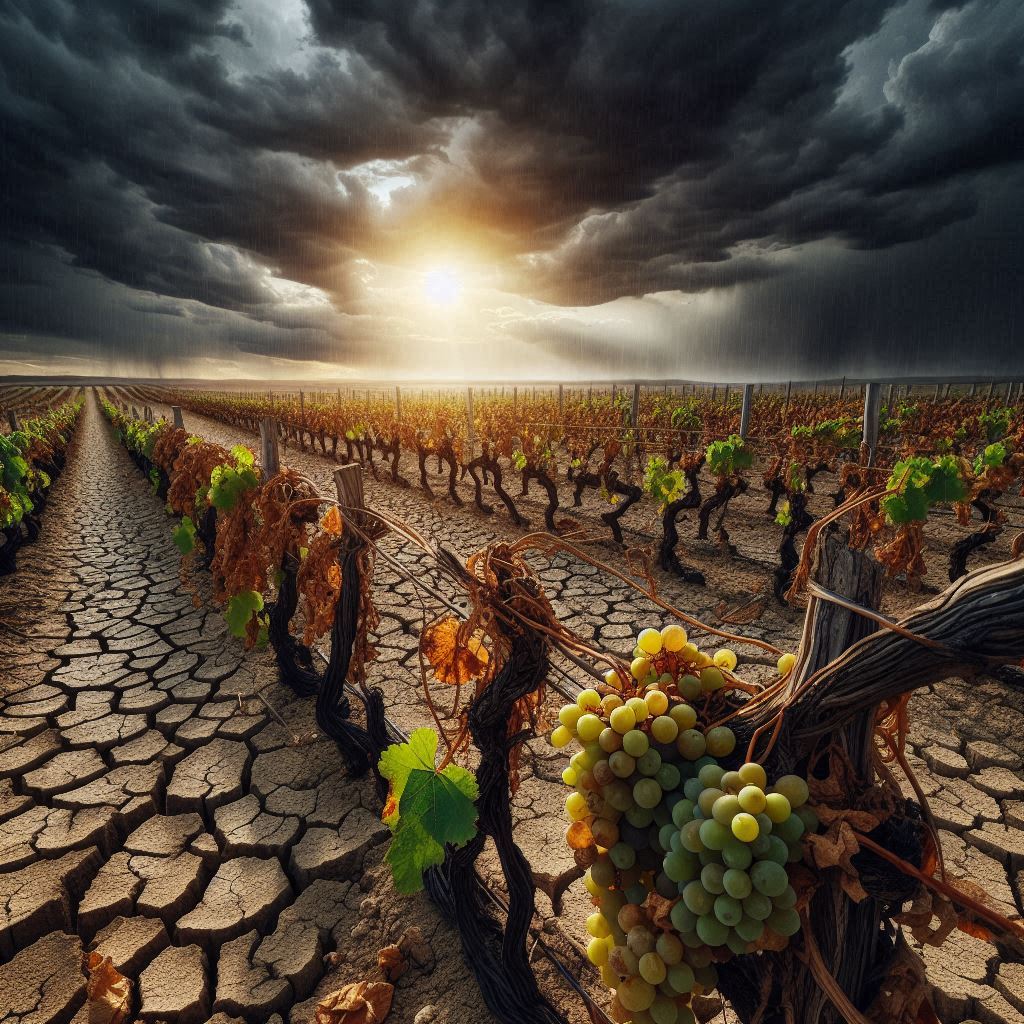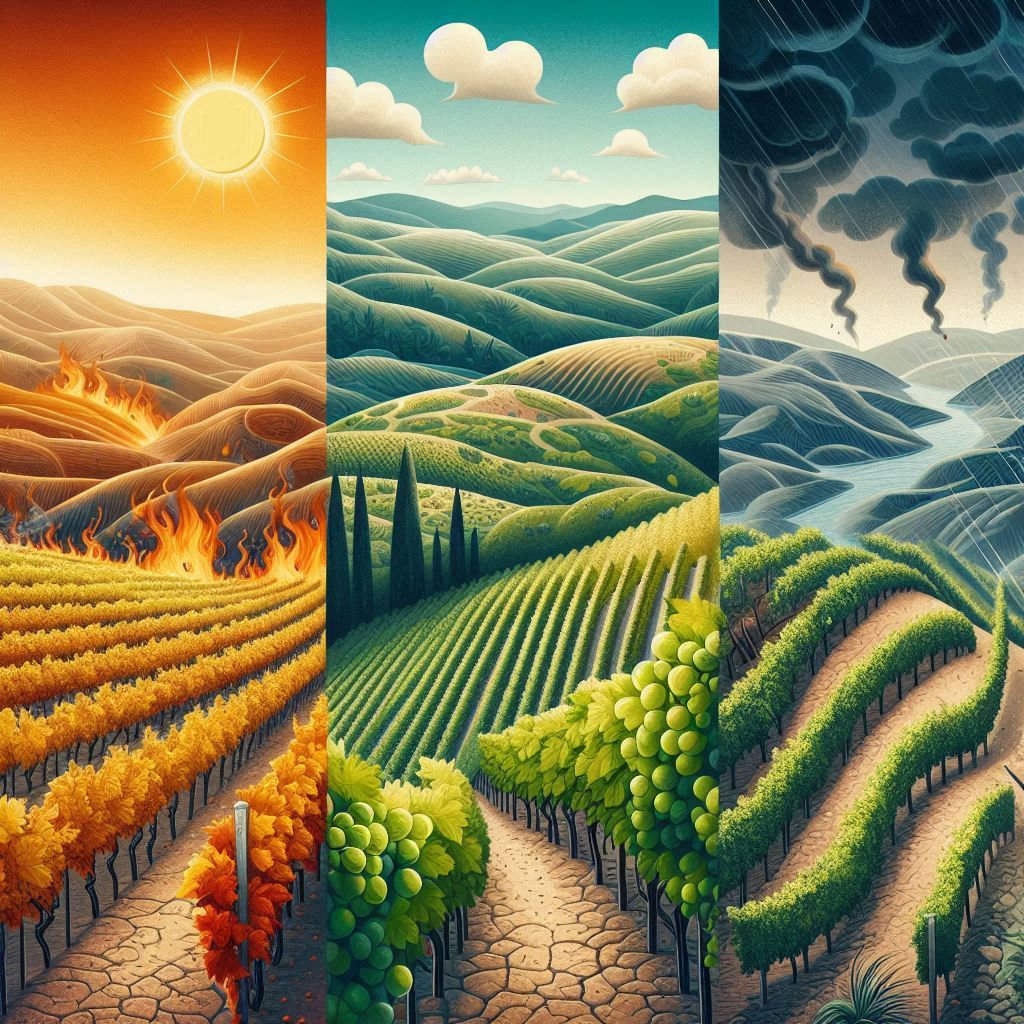
Watch short for this article (5 slides)
Vineyards on the Brink: How Climate Change is Reshaping the World of Wine
The delicate dance between grape, soil, and climate culminates in the bottle we cherish as wine. Yet, this intricate balance, honed over centuries in celebrated regions, is being profoundly disrupted. Climate change is no longer a distant threat to viticulture; it's an accelerating reality, forcing the global wine industry into an era of unprecedented adaptation. Rising temperatures, erratic weather patterns, droughts, and extreme events are altering grape chemistry, threatening iconic wine styles, shifting vineyard maps, and compelling growers and winemakers to innovate for survival. Let's explore the specific ways climate change is impacting wine production worldwide and how the industry is responding.

Climate change poses significant challenges to vineyards and wine production globally.
The Climate-Grapevine Connection: A Sensitive Relationship
Wine grapes (Vitis vinifera) are exquisitely sensitive to their environment. The concept of terroir encompasses the unique combination of soil, topography, climate, and human practices that shape a wine's character. Climate is arguably the most critical component, influencing:
- Grapevine Phenology: The timing of key growth stages like budbreak, flowering, fruit set, veraison (onset of ripening), and harvest is heavily temperature-dependent.
- Grape Composition: Temperature, sunlight exposure, and water availability directly impact the accumulation of sugars, the degradation of acids (especially malic acid), and the development of phenolic compounds (tannins, anthocyanins/color, flavor precursors) in the berries.
- Yields: Factors like spring frosts during budbreak, poor weather during flowering, drought stress, or extreme heat events can drastically reduce grape yields.
- Disease Pressure: Temperature and humidity levels influence the prevalence of fungal diseases like powdery mildew and downy mildew.
Different grape varieties have optimal climatic ranges. Cool-climate varieties like Pinot Noir and Riesling thrive where slow ripening preserves acidity and develops delicate aromatics. Warm-climate varieties like Grenache or Zinfandel require more heat to fully ripen tannins and develop characteristic flavors. Climate change is pushing these boundaries.
Impacts on the Vine: How Warming and Weather Extremes Affect Grapes
The multifaceted impacts of climate change are being felt in vineyards across the globe:
1. Rising Temperatures and Altered Ripening
- Accelerated Sugar Accumulation: Warmer temperatures speed up photosynthesis and sugar production in grapes, leading to higher potential alcohol levels in the final wine, sometimes disrupting balance.
- Acid Loss: Grapes naturally lose acidity (particularly malic acid) as they ripen, a process accelerated by heat. Lower acidity can make wines taste flat, less refreshing, and less age-worthy. This is a major concern in regions prized for freshness, like Champagne or Burgundy.
- Sugar vs. Phenolic Ripeness Mismatch: Ideally, sugars, acids, and phenolic compounds (flavor, color, tannin) ripen in sync. With rapid warming, grapes may reach high sugar levels (and thus potential alcohol) before tannins and flavor compounds are fully mature, resulting in wines that are alcoholic but taste "green" or unripe. Conversely, extended "hang time" to achieve phenolic ripeness in hot conditions can lead to overripe, jammy flavors and excessively high alcohol.
- Earlier Harvests: Harvest dates have advanced significantly (by weeks, in some cases) in many regions over recent decades, shifting picking into hotter periods, which can pose logistical challenges and impact grape quality if heat stress occurs during harvest.
- Flavor Profile Shifts: Warmer conditions can alter the aromatic profile of grapes, favoring riper, tropical fruit notes over fresher, more delicate aromas, potentially changing the traditional character of wines from specific regions.
2. Water Stress and Increased Drought Frequency
- Vine Physiology: Grapevines under drought stress close their stomata (leaf pores) to conserve water, reducing photosynthesis and potentially shutting down ripening altogether in severe cases.
- Yield Reduction: Water stress typically reduces berry size and overall cluster weight, leading to lower yields.
- Concentration Effects: While smaller berries can lead to more concentrated flavors and tannins (sometimes desirable, especially for red wines), severe drought can produce harsh, unbalanced tannins.
- Irrigation Demands: Increased reliance on irrigation puts pressure on scarce water resources, particularly in regions like California, Australia, and parts of the Mediterranean.
3. Extreme Weather Events: Growing Threats
- Late Spring Frosts: Paradoxically, warmer winters can encourage earlier budbreak, making vulnerable young shoots more susceptible to damage from late spring frosts, which can still occur even in a warming climate, potentially wiping out a significant portion of the crop.
- Intense Heat Spikes: Extreme heat events during the growing season can cause sunburn on grapes, shrivel berries, halt ripening, and damage vine foliage.
- Hailstorms: Increasingly severe convective storms can produce large hailstones capable of shredding leaves, damaging canes, and destroying the grape clusters themselves, leading to total crop loss in affected areas.
- Heavy Rainfall Events: Intense rain, especially near harvest, can dilute grape flavors, cause berries to split, and promote fungal diseases like botrytis bunch rot (though sometimes desired as "noble rot" for specific sweet wines, uncontrolled rot is detrimental).
- Wildfires: Becoming a major issue in regions like California, Australia, and parts of Europe. Beyond direct fire damage, pervasive smoke can permeate grape skins, leading to undesirable "smoke taint" characteristics (ashy, medicinal, smoky flavors) in the finished wine, rendering entire vintages unsellable. (Source: Australian Wine Research Institute - Smoke Taint)
A Shifting Map: Regional Impacts and Emerging Frontiers

Classic wine regions are grappling with maintaining their identity, while new areas become viable.
| Wine Region | Primary Climate Change Impacts | Observed Changes & Adaptation Examples |
|---|---|---|
| Champagne, France | Warmer temperatures leading to riper grapes, lower acidity, potential loss of classic freshness. Increased risk of spring frost due to earlier budbreak. | Harvest dates advancing significantly. Exploring minor traditional grape varieties (e.g., Petit Meslier, Arbane) for acidity retention. Research into new, more climate-resilient varieties and rootstocks underway. |
| Bordeaux, France | Increased heat and drought stress impacting Merlot particularly. Risk of unbalanced wines (high alcohol, lagging phenolic ripeness). More frequent extreme heat events. | Shift towards later-ripening Cabernet Sauvignon in some areas. Official approval (in 2021) for planting several new, more heat/drought-tolerant varieties (e.g., Touriga Nacional, Marselan) on a trial basis. Increased focus on soil health and water management. |
| Burgundy, France | Pinot Noir and Chardonnay highly sensitive to heat. Earlier harvests, risk of overripe flavors, loss of delicate aromatics and acidity. Increased risk of frost and hail damage. | Adapting canopy management, exploring higher-altitude or cooler-aspect sites, clonal selection for later ripening. Harvest timing becomes ever more critical. |
| California, USA | Severe drought, extreme heat waves, major challenges with wildfire smoke taint impacting vast areas. Water scarcity for irrigation is a critical issue. | Increased adoption of water-efficient irrigation, planting drought-tolerant varieties/rootstocks, moving vineyards to cooler coastal areas or higher elevations, research into smoke taint mitigation. |
| Australia (e.g., Barossa, McLaren Vale) | Significant challenges with heat waves, drought, and water availability. Bushfires pose a recurrent threat (smoke taint, direct damage). | Focus on drought-tolerant varieties (Grenache, Mediterranean varieties), water conservation techniques, innovative canopy management, exploring cooler regions (Tasmania, higher altitude sites). |
| Rioja, Spain | Rising temperatures affecting the balance and ageing potential of Tempranillo. Increased drought stress. | Shift towards planting vineyards at higher altitudes, increased interest in heat-tolerant native varieties like Graciano, adjustments in winemaking to manage alcohol levels. |
Simultaneously, previously marginal regions are emerging:
- England & Wales: Now successfully producing high-quality traditional method sparkling wines, benefiting from warmer temperatures that allow Chardonnay and Pinot Noir to ripen reliably on chalky soils similar to Champagne.
- Tasmania (Australia): Cooler maritime climate attracting mainland Australian producers seeking refuge for cool-climate varieties like Pinot Noir and Chardonnay.
- Northern Europe (Belgium, Netherlands, Scandinavia, Northern Germany): Seeing increased viability for grape growing, particularly for cooler-climate white varieties and sparkling wine production.
- Patagonia (Argentina/Chile): Cooler southern regions showing promise for varieties struggling further north.
Adapting in the Vineyard and Cellar: Strategies for Resilience

The wine industry is actively responding with a range of adaptation strategies:
1. Viticultural Adjustments (In the Vineyard)
- Canopy Management: Techniques like delayed leaf removal (to provide more shade to fruit clusters), altered shoot positioning, and experimenting with different trellis systems aim to manage sun exposure, slow ripening, and protect grapes from sunburn. Deploying shade nets in extreme heat regions.
- Cover Cropping: Planting specific crops between vine rows helps improve soil health, increase water retention, reduce erosion, suppress weeds, and enhance biodiversity.
- Water Management: Employing precision irrigation techniques like regulated deficit irrigation (RDI) to apply controlled water stress at specific times, conserving water while potentially enhancing grape quality. Improving soil water-holding capacity through organic matter additions.
- Harvest Timing: Making difficult decisions about picking earlier to retain acidity versus waiting for full phenolic ripeness, often involving meticulous sampling and analysis. Night harvesting is increasingly used in hot regions to bring in cooler fruit.
- Site Selection & Modification: Planting new vineyards at higher elevations, on cooler north- or east-facing slopes (in the Northern Hemisphere), or closer to moderating influences like oceans or lakes.
2. Genetic and Varietal Strategies
- Rootstock Selection: Utilizing rootstocks known for drought tolerance (e.g., 110R, 140Ru) or resistance to specific soil pests/diseases whose ranges might shift.
- Clonal Selection: Choosing specific clones within a grape variety known for later ripening or better acid retention.
- Exploring New or Rediscovered Varieties: Planting heat- and drought-tolerant grape varieties, either by introducing established ones from warmer regions (like Mediterranean varieties in Bordeaux) or by reviving historical local varieties that fell out of favor but possess desirable traits for a warmer climate. Breeding programs are also developing new climate-resilient crossings.
3. Winemaking Techniques (In the Cellar)
- Acidification: Carefully adding tartaric acid (a natural grape acid) during winemaking to compensate for low acidity in grapes from hot climates (a common practice in many warm regions, though regulated).
- Dealcoholization: Employing techniques like reverse osmosis or spinning cone technology to gently reduce the alcohol content of finished wines to achieve better balance (often controversial regarding impact on wine character).
- Yeast Selection: Using specific yeast strains that are less efficient at converting sugar to alcohol or that enhance certain desirable flavor profiles.
The Future Pour: Uncertainty and Innovation

The future landscape of wine is undoubtedly being reshaped by climate change. We can anticipate:
- Increased Vintage Variation: Greater year-to-year fluctuations in weather may lead to more pronounced differences between vintages.
- Shifting Regional Identities: The characteristic styles of wines from classic regions may evolve, potentially challenging traditional classifications and consumer expectations.
- Rise of New Regions: Continued emergence and growth of wine industries in previously marginal cool-climate areas.
- Focus on Sustainability: Growing emphasis on water conservation, carbon footprint reduction, soil health, and biodiversity in vineyards as integral parts of adaptation and responsible winemaking.
- Technological Innovation: Ongoing development of precision viticulture tools (sensors, drones, AI for water/nutrient management), advanced weather forecasting, and potentially new genetic tools.
While the challenges are immense, the wine industry has a long history of adaptation. Through innovation, research, strategic planning, and a deep understanding of the vine's relationship with its environment, vintners are striving to navigate the complexities of a changing climate and ensure the future of wine for generations to come.